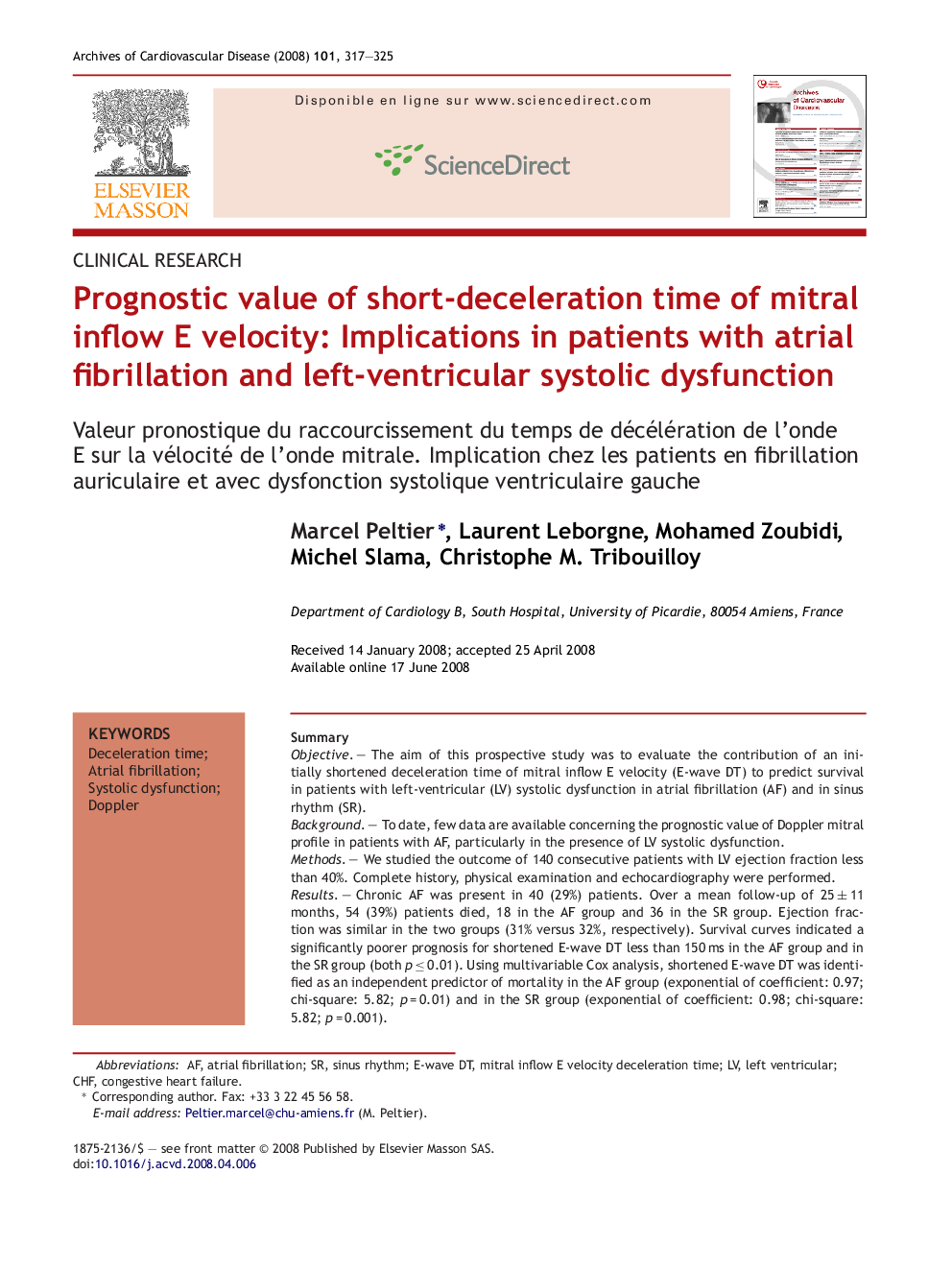| کد مقاله | کد نشریه | سال انتشار | مقاله انگلیسی | نسخه تمام متن |
|---|---|---|---|---|
| 2889711 | 1574415 | 2008 | 9 صفحه PDF | دانلود رایگان |

SummaryObjectiveThe aim of this prospective study was to evaluate the contribution of an initially shortened deceleration time of mitral inflow E velocity (E-wave DT) to predict survival in patients with left-ventricular (LV) systolic dysfunction in atrial fibrillation (AF) and in sinus rhythm (SR).BackgroundTo date, few data are available concerning the prognostic value of Doppler mitral profile in patients with AF, particularly in the presence of LV systolic dysfunction.MethodsWe studied the outcome of 140 consecutive patients with LV ejection fraction less than 40%. Complete history, physical examination and echocardiography were performed.ResultsChronic AF was present in 40 (29%) patients. Over a mean follow-up of 25 ± 11 months, 54 (39%) patients died, 18 in the AF group and 36 in the SR group. Ejection fraction was similar in the two groups (31% versus 32%, respectively). Survival curves indicated a significantly poorer prognosis for shortened E-wave DT less than 150 ms in the AF group and in the SR group (both p ≤ 0.01). Using multivariable Cox analysis, shortened E-wave DT was identified as an independent predictor of mortality in the AF group (exponential of coefficient: 0.97; chi-square: 5.82; p = 0.01) and in the SR group (exponential of coefficient: 0.98; chi-square: 5.82; p = 0.001).ConclusionIn patients with LV systolic dysfunction, a shortened deceleration time E-wave on Doppler examination appears to predict a similar poor prognosis in patients with AF as with SR.
RésuméJustificationÀ ce jour, peu de données sont disponibles concernant la valeur pronostique du profil transmitral chez les patients en fibrillation auriculaire, en particulier en présence d’une dysfonction systolique ventriculaire gauche.ObjectifL’objectif de cette étude prospective était d’évaluer la contribution d’un raccourcissement du temps de décélération mesuré sur l’onde E du flux transmitral (onde E/DT) pour prédire la survie chez les patients ayant une dysfonction systolique ventriculaire gauche, en fibrillation auriculaire et en rythme sinusal.MéthodeNous avons étudié le devenir de 140 patients consécutifs, ayant une fraction d’éjection ventriculaire gauche inférieure à 40 %. Les antécédents médicaux, l’examen physique et les données échographiques ont été réalisés.RésultatsLa fibrillation auriculaire chronique était présente chez 40 patients (29 %), avec un suivi moyen de 25 ± 11 mois, 54 patients (39 %) sont décédés, visibles dans le groupe fibrillation auriculaire et 36 dans le groupe rythme sinusal. La fraction d’éjection ventriculaire gauche était similaire dans les deux groupes (31 % versus 32 %). Les courbes actuarielles de survie montraient un pronostic plus altéré chez les patients ayant un temps de décélération de l’onde E inférieur à 150 ms dans le groupe fibrillation auriculaire et dans le groupe rythme sinusal (p < 0,01 dans les deux cas). En utilisant l’analyse multivariée selon un modèle de Cox, un temps de décélération raccourci de l’onde E était un prédicteur indépendant de la mortalité dans le groupe fibrillation auriculaire (coefficient de l’exponentiel ; 0,97 ; Khi2 : 5,82 ; p = 0.01) et dans le groupe rythme sinusal (coefficient de l’exponentiel : 0,98 ; Khi2 : 5,82 ; p = 0,001).ConclusionChez les patients ayant une dysfonction systolique ventriculaire gauche, un temps de décélération de l’onde E raccourcie sur le profil transmitral est un prédicteur d’un pronostic altéré, tant chez les patients en rythme sinusal qu’en fibrillation auriculaire.
Journal: Archives of Cardiovascular Diseases - Volume 101, Issue 5, May 2008, Pages 317–325